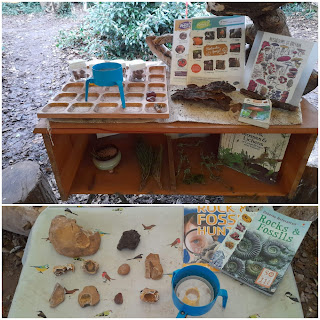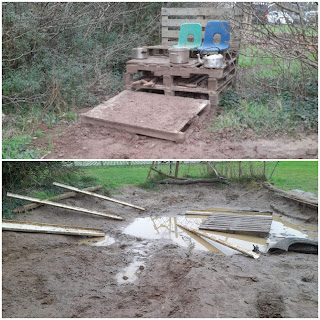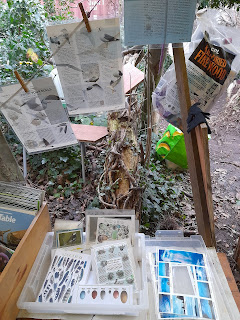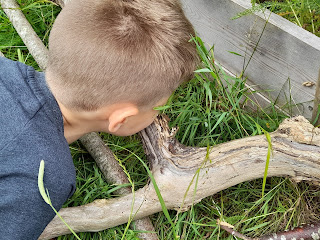How 'Child Led' works for us
All 'Child Led' learning requires following the interests of the child, but the environment in which they're learning needs both steer and support what the children want to know. There are a few factors that influence this, the site and provision being the main two.
As we have our own relatively secure site on school grounds, we can develop our site to entice children to explore something new, and we can work WITH children to create something they want.
We aim to have a lot of different activities constantly available to classes. They need to be accessible to children aged 4 to 11, and as independent to use as possible! These are a few of them:
A Nature Table of things the children have found and wanted information on, from moss & Lichen, to fossils and rock, to seed cases and leaves, and including feathers and bones! If I have a book or ID sheet to support looking these things up I leave it on the unit so children can access pictures and information when I'm not with them. Our site is full of flint and the children are fasinated about the shapes, marks, and colours they find in them.
Forest School is very physical so we have a few accessories! The rope was part of the old infant aparatus that was removed from the school, the rope ladder is repurposed from a garden climbing frame, and the swing is literally an old thick plank and rope hung from a tree! The children requested a ladder to make it easier to get into Mama Beech... and have been suprised at how difficult a rope ladder actually is to climb!
The children are encouraged to look after Forest School and one of the ways we all do that is by regular litter picking. A pedal bin and a litter grabber allow us to remove rubbish that has blown onto the site. This year we are sorting it into recyclable and non recyclable! The 'display' is all for 'bugs', invertebrates, aracnids, insects etc. We use small glass jars to collect them in and have magnifiers alongside the books and ID sheets. The children can take and return whatever they need to explore. When children show an interest in something they have found, or heard of, I will add extra info if there isn't enough!
We have a growing weather station that currently only shows wind direction and rainfall, plus has a cloud ID sheet attached. This was created with Year 3 when they decided they wanted to know how much rain had fallen over a very wet weekend.
Theres a bench with a photo album of what classes have done so far this year, so children can share what they do with each other, or use those picture cues as inspiration for their own exploring. Cards with Andrew Goldsworthy and James Brunt art on them are available to try to create, and they do either in groups or solo (see here), and a few mobile cloud ID cards.
There is plenty of tree/leaf/twig ID, especially relavant as classes are named after trees! And a small flower bed and wildlife pond. These are great spaces to find butterflies, shield bugs, and frogs, and year 2 helped to pull out the dead stalks and add them to the bug hotel (below) yesterday!
We have a couple designated wildlife spaces. There are a few bug hotels dotted around, this pallet stack being the biggest. Children have noticed birds enjoy taking dried grass form here so we often 'restock' it with things for the birds as well as the bugs.
The other structures are a safe place for hedgehogs to use - designed by the children. One complete, one to be completed! Also a bird table that we always put a biscuit on!
The children love making their own dens, but some prefer to use our structures. These can be added to for role play or just used as a quiet, mindful space. The mud is our ever popular Dig Pit and a small pallet 'mud kitchen' that also gets a lot of use!
Bird info and ID is always available, especially this term as we build up to our RSPB Big Schools' Birdwatch! This info now encompasses information on nests and eggs also as so many shells were found in spring and the classes wanted to know more.
All activities require adult input, modelling and explaining the safe and correct way to use equipment. Some activities need more support than others! Peelers are something we model every week as the children can use them mostly independently with an adult nearby rather than with adults overseeing them (dependent on age!). We do have other tools but those need to be planned-in for a time when I can be solely with that activity. This means a settled class who know the Forest School rules and generally explore safely because one TA is left overseeing the rest of the class across our large site!
The knots require the most adult supervision. Through to year 6 many children cannot tie their own shoelaces! There are one or two children who attend Brownies or Scouts and enjoy looking through the book and trying different knots, but the vast majority have to be taught one to one - and shoelaces is the most useful place to start!
Since the above photo was taken last week the small mud kitchen has been moved back a few metres and has grown!
The site is always changing, often to deal with repairs from age or over use, but frequently to be developed and adapted to make things inclusive, and to allow greater scope for more experiences.
I regularly ask the children what they think we should do in Forest School. They have the opportunity to chat about it as well as to write or draw me notes. I try to encorporate as many of their ideas as possible. For instance we used this years Woodland Trust hedging packs to extend the maze, as requested, and we're building a 'puppet theatre' for children to tell stories with the wooden characters they create.
The puppet development is more of an outdoor learning activity than a Forest School one, but as there is no learning intention attached to it, the children will use it independently, and I've no doubt it will frequently be used as a den, I'm happy to help them create this.
Our growth and focus is entirely led by the children. Obviously we have ideas ourselves, but these are almost always born from watching the children and realising how we can extend provision to help them move on with their learning.
Child Led does mean evidence of learning is not simple to collect. Having an Early Years background is helpful here, observations and photographs feed into planning and are there to show what the children experience. I have a progression of skills document, but I use that to ensure I supply the opportunity to engage in all of these rather than to tick off what each individual child participates in. This is also dictated by having 16 classes, across 3 key stages, and including a SEND unit accessing Forest School regularly across the year. Individual learning assessment is not practical!
Child led independent learning works best within routine and a safe, engaging environment. However spending time with the children, talking to them, joining in with them, watching them, and listening to them, gives me insight into what each child is interested in, has achieved, and where they need support will always move learning forward.
We see children achieve and develop each session, and feedback from class teachers helps to understand how well that is transferring into school life.
Again I'm going to bang on about the importance of having great staff outside to support Forest School. People who will talk to me, make suggestions, let me know if a child needs extra space or support when they arrive, and are willing to get involved themselves.
Staff who can see beyond the 'playing' to the learning going on and help to develop and extend it.
I am the only Forest School Leader on staff, but delivering sessions has to be about teamwork, and really that's not just between me and support staff, but between adults and children.


















Comments
Post a Comment